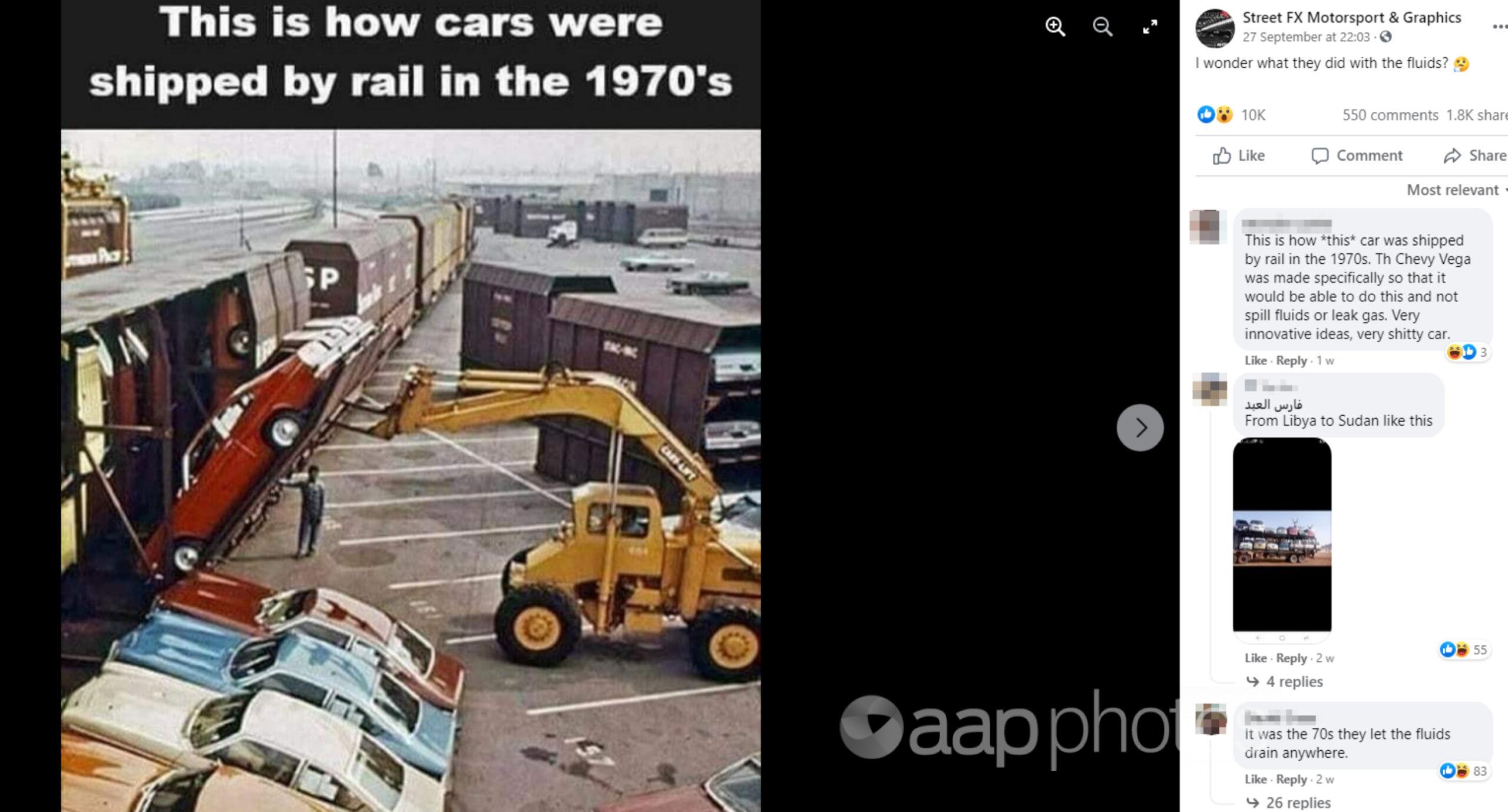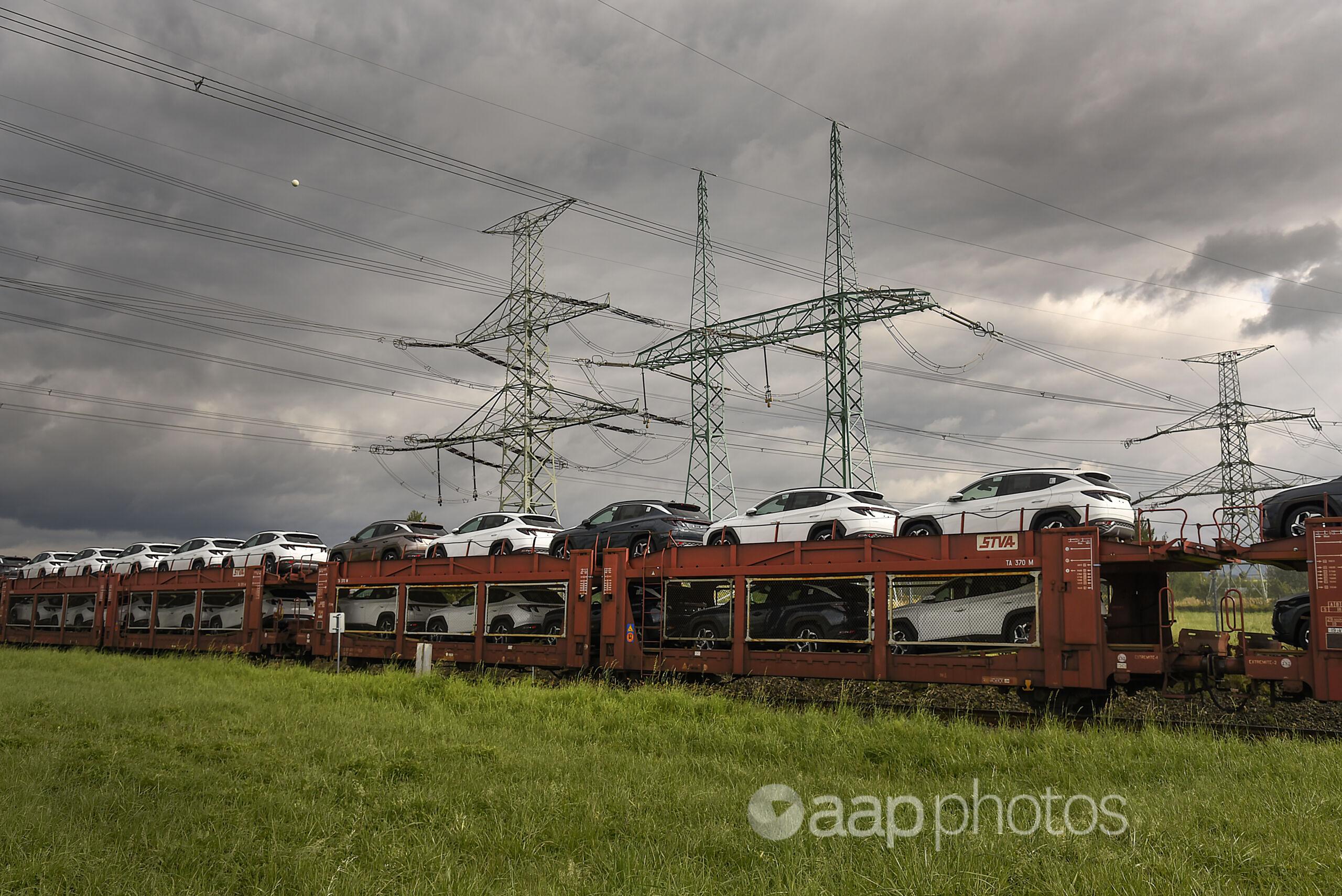The Statement
An Australian Facebook page has posted a photo of cars being loaded vertically into a freight train carriage, with text in the same meme reading: “This is how cars were shipped by rail in the 1970’s (sic).”
“I wonder what they did with the fluids?,” the caption on the September 27 post asks.
At the time of writing, the image had been viewed more than 2.6 million times and shared more than 1800 times. It was posted by Street FX Motorsport & Graphics, a page with more than 10 million followers.
In 2016, the same photo and text were posted by the UNILAD Tech Facebook page, attracting more than 2400 shares and 15,000 reactions.

The Analysis
The photo shows several Chevrolet Vega cars being loaded on freight train carriages in the US in 1971. However, the transportation system was not in widespread use in the 1970s as implied by the posts. Rather, it was designed specifically for the Vega and was unique to the model.
The Chevrolet Vega was a sub-compact car produced by the Chevrolet division of General Motors that launched in 1970 with a pricetag of around $US2100. Its launch came during the Chevrolet tenure of renowned car maker John Z. DeLorean, who later left Chevrolet to set up the DeLorean Motor Company, best-known for the DMC DeLorean sports car featured in the Back to the Future movie series.
The reason Vega cars were transported vertically was essentially down to economics. At the time, a typical bi-level or tri-level freight train held eight to 15 cars, according to a New York Times article published in June 1969.
Car transporter carriages were also open-sided, leaving the new cars exposed to theft and vandalism. Vandalism of new cars was a significant problem for car manufacturers at the time, with vehicles regularly incurring “window breakage, aerosol paint spraying, bullet holes and even knife-slashed tires and upholstery” during transit to dealerships, according to a Popular Science article from the time.
As a solution, General Motors teamed up with Southern Pacific Railroad to develop a new space-saving carriage system known as Vert-a-Pac, designed for the new line of Vega cars. A rebadged version of the Vega – the Pontiac Astre – was also transported via the Vert-a-Pac method by GM.
Not only did Vert-a-Pac allow 30 Vegas to be stacked into a single carriage, it also had a closed-wall design that protected the vehicles during transportation across the US, according to a Motor Trend article. To load the carriages, cars were driven onto a ramp at the side and bolted down in place. Once the ramp was fully loaded, a forklift would tilt it into the carriage and close the door, forcing the cars into a nose-down position inside.
The unique transportation method also created some challenges. Most notably, a raft of design modifications was needed to prevent fluid spillage while the cars were tipped on their nose, including baffles in the oil pan to prevent liquid draining out, caps on the rear side of the battery to stop any leakage, and a windshield-washer fluid bottle positioned at a 45-degree angle, according to an article in trade journal Railway Age.
Despite being named Motor Trend magazine’s Car of the Year 1971, the Chevrolet Vega was beset by a series of mechanical faults such as randomly stalling in traffic, loose window wipers, fuel spills and an undercarriage clearance height that turned out to be too low for automatic car washes.
After multiple recalls and falling sales, production of the Vega ended in July 1977. In 2020, Motor Trend described the Vega as “a promising car that turned out to be truly terrible”.
The General Motors Heritage Center in Sterling Heights, Michigan, confirmed to AAP FactCheck the post’s photo depicted Chevrolet Vegas being loaded onto a Vert-a-Pac carriage in 1971 and that the same image had been located in the GM archives. A spokeswoman said the Vert-a-Pac system was not used to transport any other car models.
The photo’s circulation on the internet in articles correctly describing it as showing Chevy Vegas goes back to at least 2011.
Car historian Michael Lamm – who has written several books about US car design – told AAP FactCheck he was unaware of any other car models being transported vertically like the Vega.
The Verdict
The photo shows Chevrolet Vega cars being loaded vertically onto a freight train in 1971. However, the Vega was the only model to use the unique Vert-a-Pac system, which was designed specifically for the car. Other cars in the 1970s were transported horizontally by rail.
Partly False – Content that has some factual inaccuracies.
* AAP FactCheck is an accredited member of the International Fact-Checking Network. To keep up with our latest fact checks, follow us on Facebook, Twitter and Instagram.
All information, text and images included on the AAP Websites is for personal use only and may not be re-written, copied, re-sold or re-distributed, framed, linked, shared onto social media or otherwise used whether for compensation of any kind or not, unless you have the prior written permission of AAP. For more information, please refer to our standard terms and conditions.


















